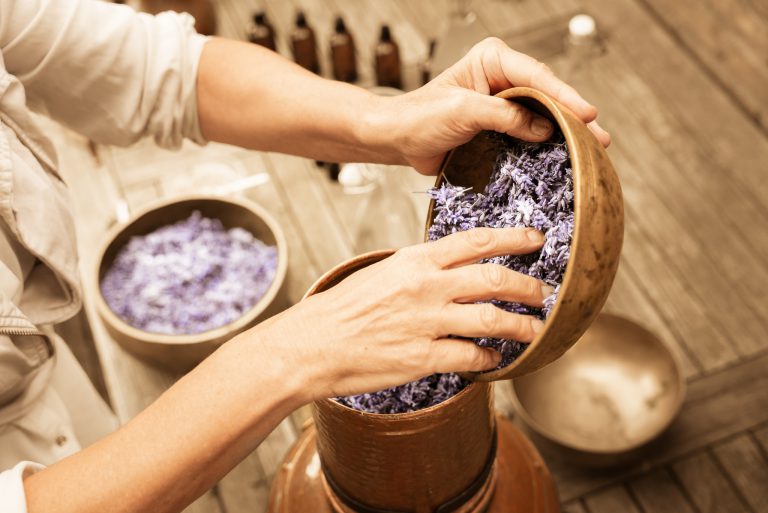When I walk through my garden, my eyes often fall on the glossy leaves of my laurel bush. It is the Laurus nobilisthe true laurel. As soon as I run my fingers along a leaf, a fresh, spicy aroma is released — a scent that immediately brings clarity to my mind and a sense of grounding in my legs. For me, laurel is much more than a culinary herb. It is a plant with a powerful, pure energy.
In this blog, I take you on a journey from leaf to essential oil, showing how laurel leaves transform into therapeutic aromas released during distillation, and exploring the strength and wisdom this plant holds. If you want to know more about why plants have scent, you can read my blog on that topic.

The laurel bush (Laurus nobilis) strength in simplicity
The Laurus nobilis is an evergreen shrub that, if left unpruned, can grow to over two metres tall. The leaves are leathery, lance-shaped, and shine beautifully in the sunlight. When you stroke a leaf, a subtle, fresh scent is released; crush it gently between your fingers, and a more powerful aroma unfolds; fresh, spicy, with a hint of warmth.
Laurel (Laurus nobilis) is a robust Mediterranean shrub that surprisingly thrives in a variety of climates. In countries such as Italy, Greece, and Turkey, it grows naturally on sunny slopes and at forest edges, but it also does very well in the Netherlands and Belgium, either in containers or planted in the ground, as long as it is sheltered from severe frost.
You can, just like me, keep it in your garden, in a pot on the terrace, or even as a houseplant in a bright space. It prefers:
- a sunny to partially shaded spot (preferably sheltered from cold winds)
- well-draining, lime-poor soil
- regular pruning to keep it compact and healthy
A fun fact: In southern countries, laurel can grow into a small tree reaching 8–10 metres, whereas in our regions it usually remains a shrub of 1–2 metres.
Symbolism and ancient uses of laurel
Laurel is a plant with a rich history, full of symbolism. For thousands of years, it has represented purity, protection, insight, and victory.
Here is a collection of ancient wisdom and rituals associated with laurel:
- In ancient Greece, poets, philosophers, and heroes were crowned with a laurel wreath, a symbol of wisdom, victory, and a pure mind.
- Roman leaders wore laurel crowns as a sign of strength and protection.
- According to Greek mythology, Daphne transformed into a laurel tree to escape Apollo. Since then, laurel has been seen as a symbol of immortality and inner protection.
- In the Middle Ages, laurel was used to purify the home and spirit; branches were hung above doors or burned during illness to cleanse the air.
- In ancient Rome, laurel leaves were scattered on floors during celebrations, allowing the scent to purify the space and offer protection.
- In some folk traditions, a laurel leaf was placed under the pillow to encourage clear dreams or receive insight.
For centuries, laurel has been regarded as a bearer of clarity, strength, and wisdom. Qualities I still experience today in my work with this remarkable plant.
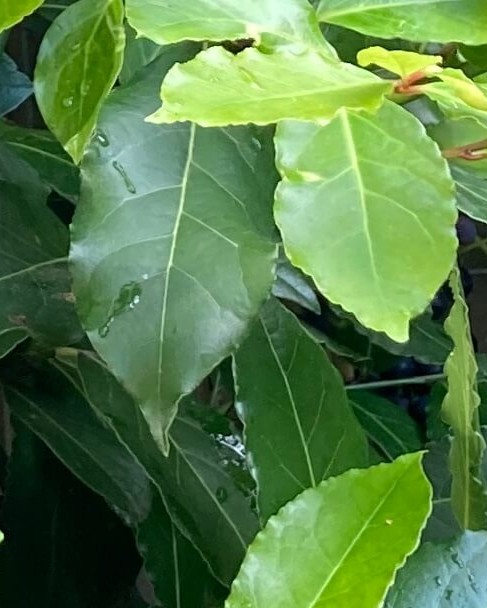
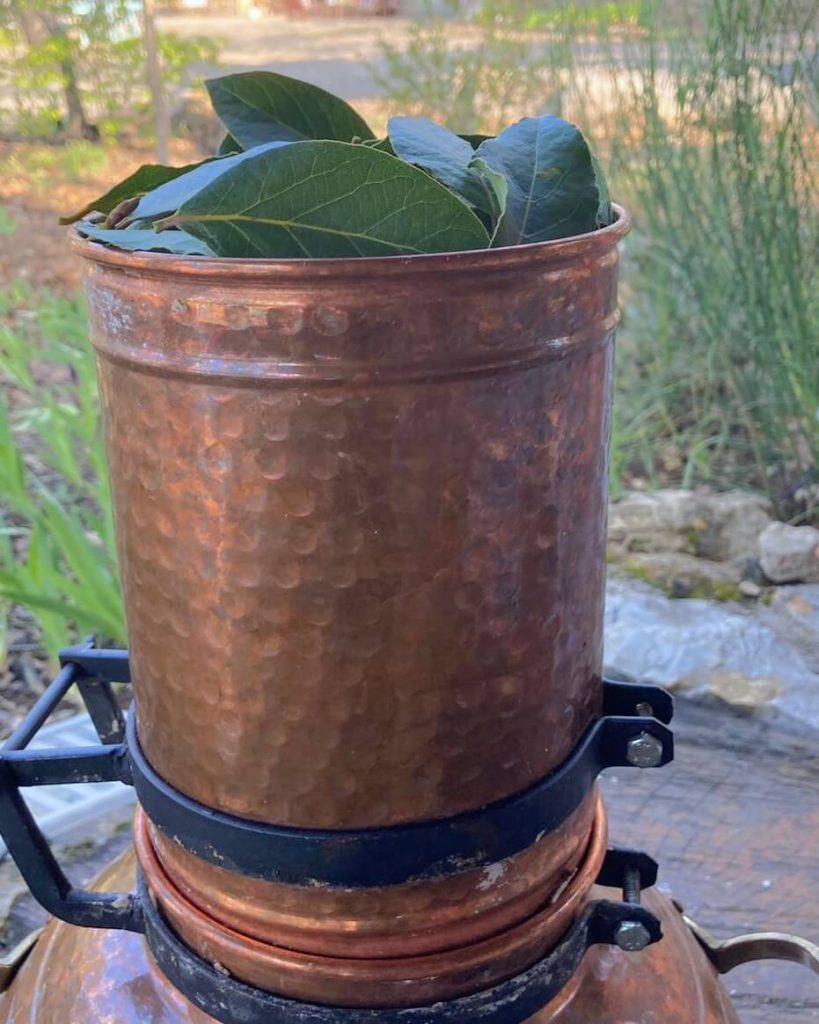
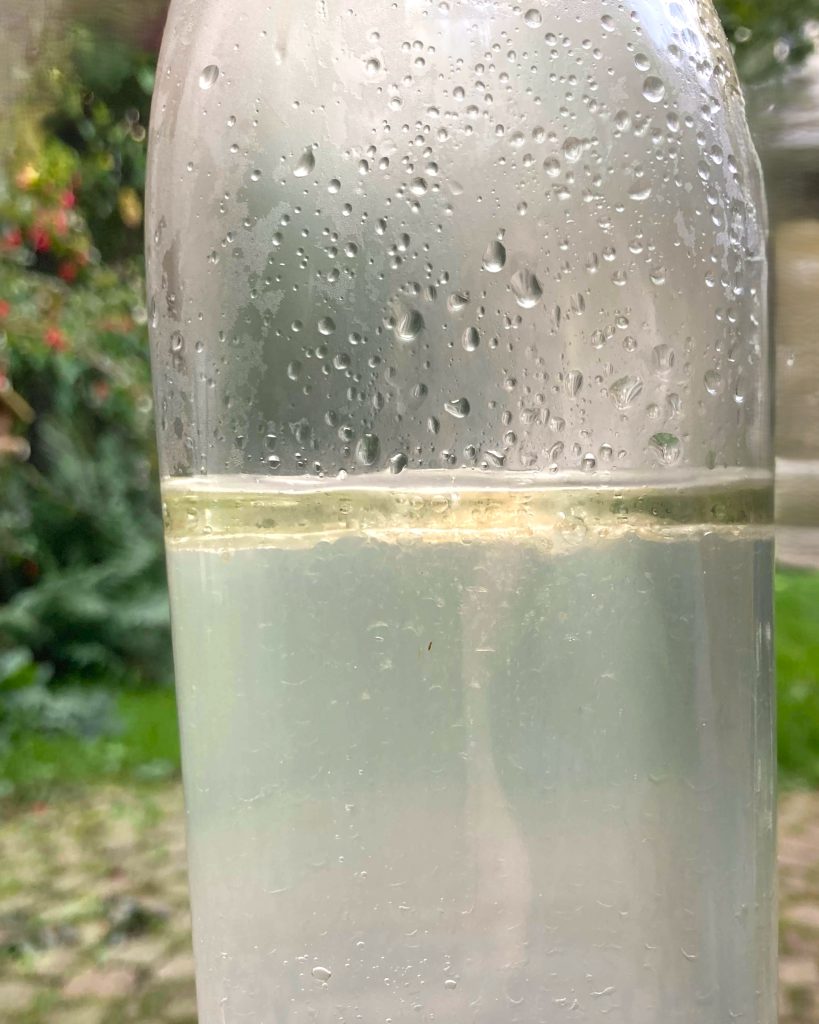
From leaf to oil: harvesting and distillation
Harvesting laurel leaves is for me a moment of mindfulness and connection. I select sturdy, healthy leaves, preferably in the morning when the concentration of aromatic molecules is at its peak. Using a sharp pair of scissors, I carefully snip them from the branches and fill my harvest bag with fragrant leaves.
In my distillation still, an almost alchemical process slowly begins. As the steam rises, the room fills with the spicy scent of laurel. After around 45 minutes, the first drops of liquid appear. Droplets full of vitality and strength.
What initially appears milky gradually separates into clear hydrolate and a thin layer of golden oil
From approximately 600 grams of fresh laurel leaves — a bag full of green — I obtain an average of two millilitres of essential oil. After a few hours of distillation, I have a few millilitres of oil and a bottle of fragrant hydrolate: concentrated, pure nature. A fresh, spicy scent with a hint of warmth and sweetness — a fragrance that opens you to life.
Fun fact: laurel oil was already used in ancient Egypt during rituals honouring the sun and as a purifying element in temple ceremonies.
If you would like to experience capturing a plant’s scent yourself, there are several ways to do so. Let yourself be inspirered
The power of laurel oil (essential oil)
Scientific research shows that laurel oil is rich in compounds such as 1,8-cineole, sabinene, eugenol, and linalool. These components are known for their antioxidant, anti-inflammatory, and antimicrobial properties.
They support the natural immune system, can open the airways, and help release tension. Laurel oil helps to think clearly, boosts self-confidence, and relieves stress.
Laurel oil helps to think clearly, boosts self-confidence, and relieves stress. It is an oil that brings body and mind back into balance. Curious about how scents influence you? You can read more in my blog on the psychology of fragrance
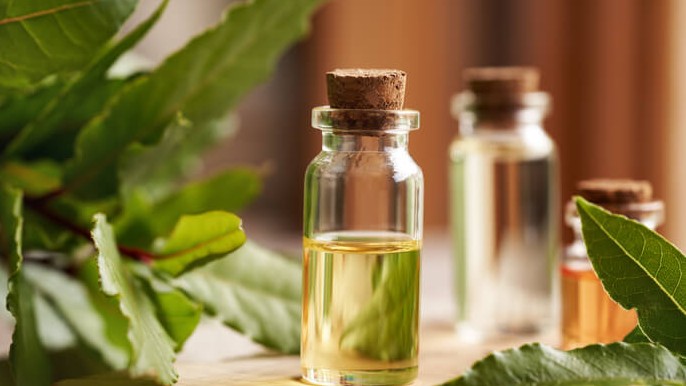
Uses in aromatherapy
In aromatherapy, I love to use laurel oil to bring clarity, support focus, and strengthen confidence. It is a scent that helps with mental pressure, fatigue, and stress, contributing to inner balance.
During the cold season, I often use laurel in a steam bath, diffuser, or warming bath for muscle tension. It is an oil that literally opens the airways.
- For colds or flu: add a few drops to a steam bath or diffuser.
For a bath, always use a carrier, such as a handful of sea salt with a few drops. Alternatively, mix in a small bowl of yogurt with honey and a few drops of essential oil, then combine with the bathwater. - For muscle pain or fatigue: mix 1–2 drops of laurel oil in 10 ml of carrier oil and massage into the neck, shoulders, or back.
- For mental pressure or exam stress: diffuse the oil in the room to promote clarity and focus, or place a drop on a porous stone.
- For energy and courage: inhale the scent consciously in moments when you need strength.
Fact: the scent of laurel stimulates “clear thinking” — in fragrance psychology it is often used to support decision-making or relieve performance anxiety.
Laurel hydrolate: a gentle touch
After distillation, laurel hydrolate remains: the fragrant water containing the water-soluble constituents of the plant.
The hydrolate has a mild, herbal scent and is softer than the essential oil. Because it is still aromatic, I often dilute it with mineral water. I use it in sprays, baths, or as a facial toner.
It works soothingly, purifying, and slightly astringent, making it ideal for oily skin or moments of fatigue.
Mentally, it has a purifying effect: it helps release tension and stay present with awareness.
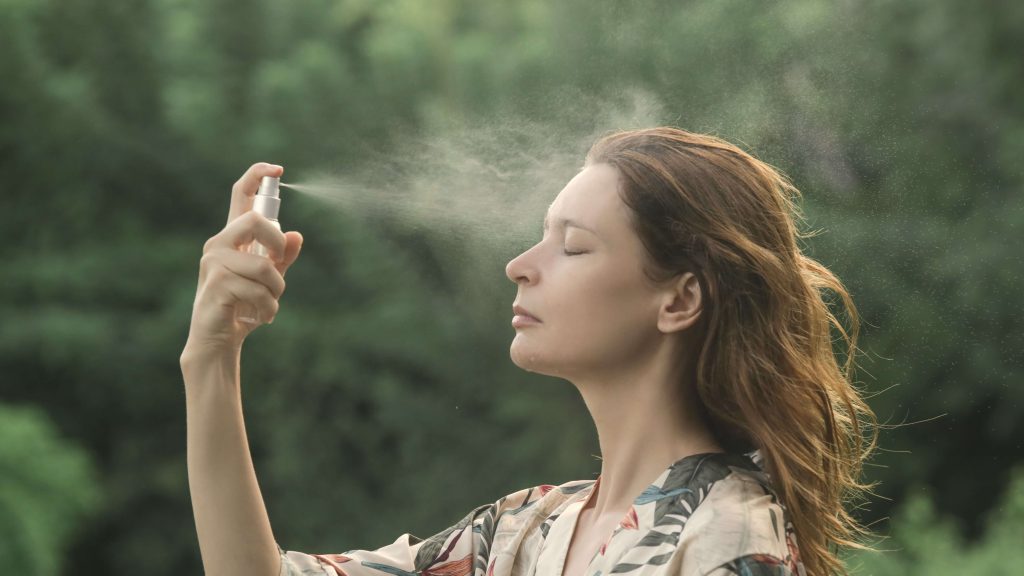
Practical uses for laurel hydrolate:
- Spray it around a room for a fresh, clean atmosphere.
- Use it as a natural aftershave or facial refresher.
- Add a splash to your bathwater for a gentle relaxing experience.
- Combine with rose or lavender hydrolate for a harmonising effect.
- Use as a mouth rinse or gargle for infections.
Although scientific research on hydrolates is still limited, experience shows that laurel hydrolate brings balance and clarity — subtle yet perceptible. For more inspiration, see my blog on hydrosols for additional tips.
Conscious and safe use
Laurel oil is powerful and calls for respectful application.
- Always dilute in a carrier oil (maximum 1–2%).
- Do not use during pregnancy or on children under 6 years old.
- Do not ingest; essential oils are highly concentrated and can irritate skin or mucous membranes if used undiluted.
As you inhale the scent, allow yourself to experience and discover what the plant has to share. In every drop, the connection between science, tradition, and sensory experience can be felt.
Experience it yourself: three simple ways
You don’t need to have essential oil at home to experience the power of laurel.
There is likely a laurel bush nearby where you can pick a leaf.
- Inhale: place a few leaves in warm water and breathe in the rising steam slowly.
- Crush and smell: rub a leaf between your fingers and let the aroma open your attention.
- Op je werkplek: At your workspace: place a few leaves nearby, touch them occasionally, and experience their calming presence.

Scent and wisdom
Laurel invites you to pause, feel, and experience. The leaf, the scent, the oil, and the hydrolate tell a story of ancient wisdom and contemporary application.
When you walk with me through a garden, witness an alchemical process, or smell an aroma, you discover not only the plant but also the wisdom it carries through the ages.
Take the time to notice the scents around you, experience a laurel leaf, and let its power and clarity inspire you.
Plant wisdom of laurel:
"I cleanse your mind and refresh your spirit. I give clarity and decisiveness. With this fresh energy, I empower you to take action."
Do you want to experience this for yourself?
In my workshops, trainingen en Study tours I guide you into the world of plant aromas, aromatherapy, and inner connection — where scent allows you to smell, feel, and remember.

